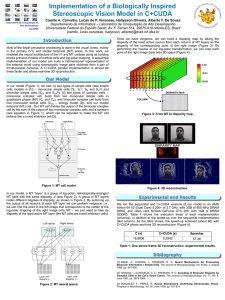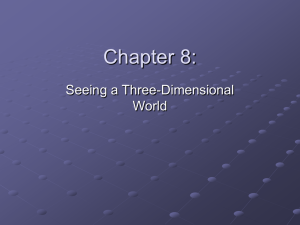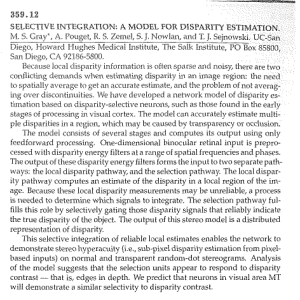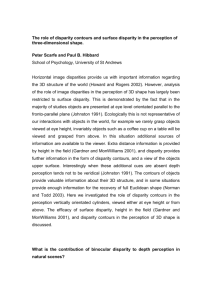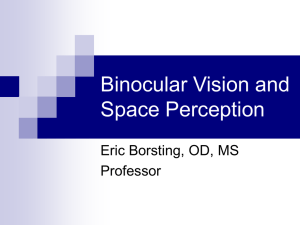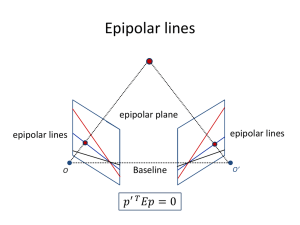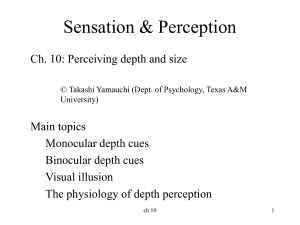Author Guidelines for 8
advertisement
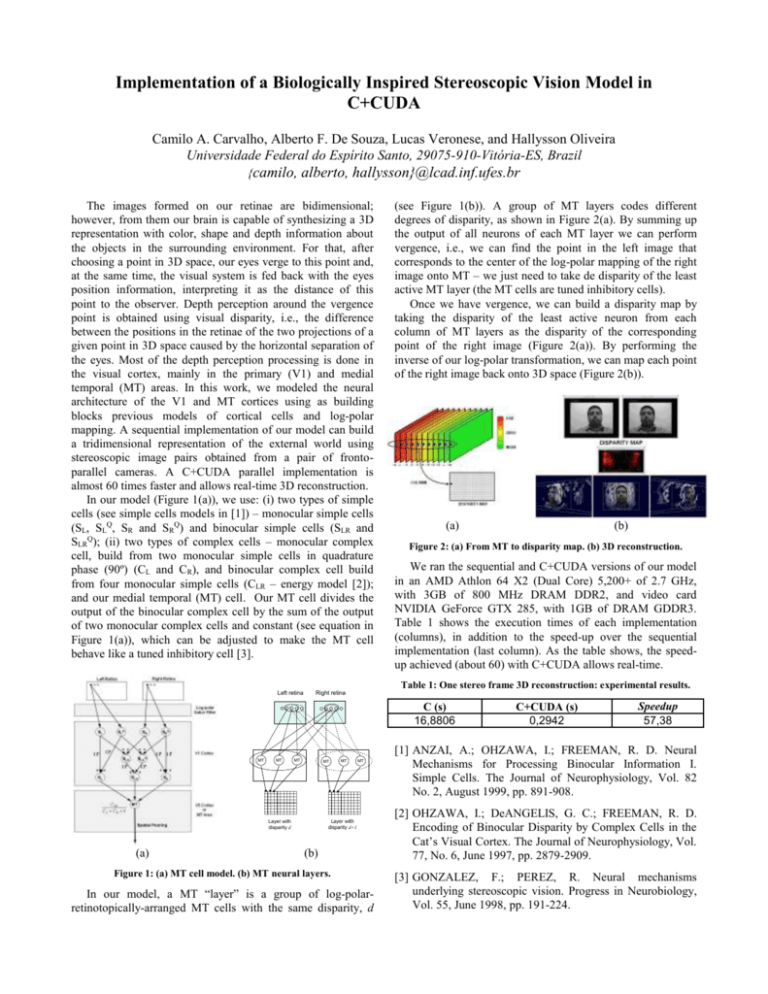
Implementation of a Biologically Inspired Stereoscopic Vision Model in
C+CUDA
Camilo A. Carvalho, Alberto F. De Souza, Lucas Veronese, and Hallysson Oliveira
Universidade Federal do Espírito Santo, 29075-910-Vitória-ES, Brazil
{camilo,
alberto, hallysson}@lcad.inf.ufes.br
The images formed on our retinae are bidimensional;
however, from them our brain is capable of synthesizing a 3D
representation with color, shape and depth information about
the objects in the surrounding environment. For that, after
choosing a point in 3D space, our eyes verge to this point and,
at the same time, the visual system is fed back with the eyes
position information, interpreting it as the distance of this
point to the observer. Depth perception around the vergence
point is obtained using visual disparity, i.e., the difference
between the positions in the retinae of the two projections of a
given point in 3D space caused by the horizontal separation of
the eyes. Most of the depth perception processing is done in
the visual cortex, mainly in the primary (V1) and medial
temporal (MT) areas. In this work, we modeled the neural
architecture of the V1 and MT cortices using as building
blocks previous models of cortical cells and log-polar
mapping. A sequential implementation of our model can build
a tridimensional representation of the external world using
stereoscopic image pairs obtained from a pair of frontoparallel cameras. A C+CUDA parallel implementation is
almost 60 times faster and allows real-time 3D reconstruction.
In our model (Figure 1(a)), we use: (i) two types of simple
cells (see simple cells models in [1]) – monocular simple cells
(SL, SLQ, SR and SRQ) and binocular simple cells (SLR and
SLRQ); (ii) two types of complex cells – monocular complex
cell, build from two monocular simple cells in quadrature
phase (90º) (CL and CR), and binocular complex cell build
from four monocular simple cells (CLR – energy model [2]);
and our medial temporal (MT) cell. Our MT cell divides the
output of the binocular complex cell by the sum of the output
of two monocular complex cells and constant (see equation in
Figure 1(a)), which can be adjusted to make the MT cell
behave like a tuned inhibitory cell [3].
Left retina
(see Figure 1(b)). A group of MT layers codes different
degrees of disparity, as shown in Figure 2(a). By summing up
the output of all neurons of each MT layer we can perform
vergence, i.e., we can find the point in the left image that
corresponds to the center of the log-polar mapping of the right
image onto MT – we just need to take de disparity of the least
active MT layer (the MT cells are tuned inhibitory cells).
Once we have vergence, we can build a disparity map by
taking the disparity of the least active neuron from each
column of MT layers as the disparity of the corresponding
point of the right image (Figure 2(a)). By performing the
inverse of our log-polar transformation, we can map each point
of the right image back onto 3D space (Figure 2(b)).
(a)
Figure 2: (a) From MT to disparity map. (b) 3D reconstruction.
We ran the sequential and C+CUDA versions of our model
in an AMD Athlon 64 X2 (Dual Core) 5,200+ of 2.7 GHz,
with 3GB of 800 MHz DRAM DDR2, and video card
NVIDIA GeForce GTX 285, with 1GB of DRAM GDDR3.
Table 1 shows the execution times of each implementation
(columns), in addition to the speed-up over the sequential
implementation (last column). As the table shows, the speedup achieved (about 60) with C+CUDA allows real-time.
Table 1: One stereo frame 3D reconstruction: experimental results.
Right retina
C (s)
16,8806
MT
MT
MT
MT
MT
Layer with
disparity d+1
Layer with
disparity d
(a)
MT
(b)
(b)
Figure 1: (a) MT cell model. (b) MT neural layers.
In our model, a MT “layer” is a group of log-polarretinotopically-arranged MT cells with the same disparity, d
C+CUDA (s)
0,2942
Speedup
57,38
[1] ANZAI, A.; OHZAWA, I.; FREEMAN, R. D. Neural
Mechanisms for Processing Binocular Information I.
Simple Cells. The Journal of Neurophysiology, Vol. 82
No. 2, August 1999, pp. 891-908.
[2] OHZAWA, I.; DeANGELIS, G. C.; FREEMAN, R. D.
Encoding of Binocular Disparity by Complex Cells in the
Cat’s Visual Cortex. The Journal of Neurophysiology, Vol.
77, No. 6, June 1997, pp. 2879-2909.
[3] GONZALEZ, F.; PEREZ, R. Neural mechanisms
underlying stereoscopic vision. Progress in Neurobiology,
Vol. 55, June 1998, pp. 191-224.
